
| John Scarnell four stroke |
Len Lara 30cc two stroke |
Dickie Phillips 30cc twin |
12cc twinshaft |
| Oliver style twinshaft |
Scaled down EM 30 |
John Scarnell two stroke |
Grayspec |
| Typhoon |
10cc Pioneers |
5cc Pioneer |
EM 30 |
|
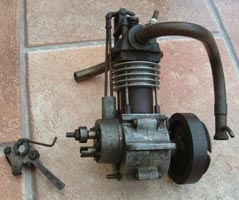 |
A Fleetwood four-stroke This venerable four-stroke
is another of the late John Scarnell's motors from his time at the
Fleetwood Club in the 1930s. The engine is either 25 or 30cc and could
have come from a variety of sources. The same basic design was marketed
by Bonds, Gamages, Grays and F.N. Sharp who is credited with the
original design. The very long inlet pipe indicates that it is an early
version with no carburettor in the accepted sense. The contact breaker
mechanism with the arm to advance or retard the ignition is to the left
of the motor.
Thanks to Dave Scarnell for this item and the photos.
Dec 2010 |
|
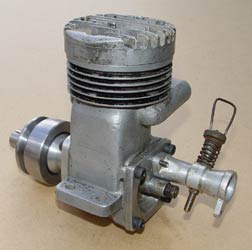 |
Len Lara's 30cc motor. From the end of the 1940s
right through to the late 60s, the 'A' Class was the province of
home built
30cc two stroke motors. Most of these were cast up at the builders
homes, although some such as Norman Hodges' Tiger 30 and Mr Swanson's
Saturn 30 were supplied in kit form. There is no way of knowing just how
many different 30s there were, but they were all essentially scaled up
McCoys. This one was built by Len Lara of the Victoria Club and at some
stage blew apart. His son Norman passed the welded case on, along with a
bag of assorted bits that included most of the missing engine parts. Ron
Hankins did a super job of rebuilding the motor, which now resides in
the late Ernie Clark's recently restored, twin hulled boat.
Thanks to Norman for this item and to
Ron for the superb rebuild. OTW photo Nov 2010 |
 |
A very rare twin Dickie Phillips
was an exceptionally fine engineer, who made his name in C class racing
in the 1950s. He started building this 30cc twin around 1938 because
'there did not seem to be any others in existence'. It was fully described
in Model Engineer in the early years of the war. Strangely, he did not
build a boat for it until several years later, when it appeared in an
enlarged version of the Westbury 24" hydro.
What is so unusual about this motor is the lack
of any transfer passages or ports. Just visible through the exhaust ports
in the image below are the four tiny transfer valves opened as the
piston descends. |
 |
The pistons also controlled the more conventional sideport carburation.
The workmanship on this motor is superb, even down to the hand made
spark plugs.
Thanks to John Hyder for this lovely item
Oct 2010 |
|
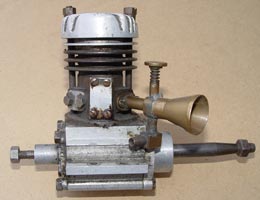 |
An even bigger twinshaft The cylinder on this motor with two inlet
ports and the transfer between looks familiar and the whole air of the
top half of the motor gives the impression of age. The crankcase might
well be a later modification. The use of multiple venturis was well
established, both in models and full sized motors, such as the Villiers
Starmaker. It is a massive engine, yet the capacity is just 12cc with a
14mm plug in a 25mm bore. The brass venturi is quite magnificent
considering the tiny intake tube.
Photo OTW Sept 2010 |
|
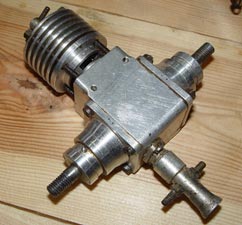 |
A 'tasty' twinshaft Engines built by the
Olivers
in Nottingham and in
particular, the 'Tiger' twinshaft and derivations,
dominated the 1.5cc and 2.5cc classes for many years. Many 'home brewed'
copies were put together, either built entirely from scratch or
utilising a variety of commercial components. It is not known at present
who put this well engineered version together, but certainly, the
induction system would not appear to be the normal crankshaft rotary
valve. Perhaps careful perusal of photographs in Model Cars or MCN might
reveal the builder?
Thanks to Bill Langley for this item.
Photo OTW Aug 2010 |
|
David Giles has contacted us
and thinks that Ken Robinson may have had a
hand in this motor. He also explained the induction is controlled by a
large cut out in one of the crank discs. Confirmation of this would be
most welcome. |
|
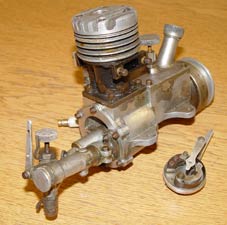 |
It is, but it isn't This motor was supposed to be
an English Mechanics 15, except that particular motor designed by W.
Cooper of King's Lynn is completely different. Close examination gave a
clue to its true origins. It is an exact scale replica of the English Mechanics 30
reduced in size to make it a 15. What is confusing is that the oil tank
is an original EM casting. This superb piece of engineering was built by
Norman Dixon of the Heaton Club for his hydro Qwik Kit to go with the
30cc Fast Cat with its full sized EM motor. Both boat and engine are now
in the hands of Tom Clement and awaiting restoration. (See bottom of
page for details of EM30)
Thanks to Tom for this fascinating piece of high quality engineering.
Photo OTW July 2010 |
|
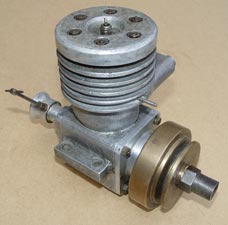 |
A 'Speculative eBay bid' It was only after the
eBay auction finished that the history of this engine came to light. It
was built by John Scarnell who started racing with the Fleetwood Club
around 1931 along with Charles Booth. In the late 40s John built a
series of two stroke motors, one for each of the classes. Most of the
30cc motors built at the time were enlarged versions of the McCoy, but
his motor has the distinctive 'Bulge bypass' of a Dooling. With generous
bearing surfaces and solid construction, there is no reason to suppose
that this motor would not run quite happily in a period hull.
June 2010. Thanks to David Scarnell
for details. Photo OTW |
|
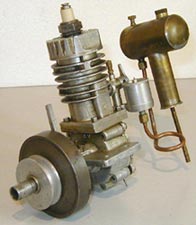 |
The 'Grayspec' is born! In 1932, Lionel French
(Spectator) described in Model Engineer the building of a 40" 'Express
Cruiser' and indicated that he would describe building a small IC engine
in two versions to power it. The original, simple, water cooled version
never materialized, and instead in 1933 French published the plans and
building instructions for a much higher performance, air cooled, 15cc
motor that would be suitable for 'B' Class hydroplanes as well. Grays of
Clerkenwell undertook to provide the castings in Electron magnesium
alloy under the name the 'Gray Special' (grayspec). Eventually it was
offered in aero or marine versions with different crankcase castings.
The marine model sold for £4-2-6
This fine version in boat configuration is by courtesy
of Ken Smith. May 2010 |
|
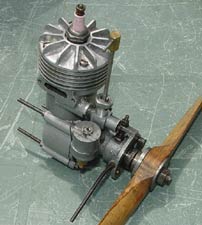 |
A very rare Typhoon Available from the Model
Aircraft Stores in Bournemouth from 1946, this 10cc engine was
'guaranteed', although what for or against was not explained. It was
claimed that this motor had been 'Specially designed for speedboats and
racing cars', although the four extended crankcase bolts for radial
mounting would hardly indicate those uses. What is obvious and unusual
is the forward facing venturi on this sideport motor.
It was an engine out of its time, and at a cost of £10-10 it was
hardly cheap, and probably not madly powerful either, which may account
for its short existence.
Thanks to Eric Offen for this unusual and rare motor.
April 2010 |
|
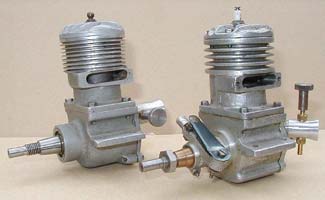 |
A pair of Pioneers These two lovely 10cc motors
were also built by Sid Smith of Chatham around 1948. The spark ignition
version on the right is markedly different, apart from the finning. The rotary
valve backplate has an angled venturi with an extended shaft, possibly
for driving a magneto. the glow model on the left has a straight
venturi. There are also other noticeable differences in the crankcase
castings. Perhaps Ken Smith will relate the story of these British
racing motors at some stage in the future. How he came by them is a
fascinating tale on its own.
Thanks to Ken for photos of these engines
March 2010 |
|
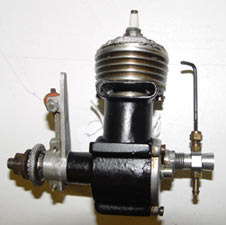 |
A very rare Pioneer In 1948, Sid Smith of Chatham
produced two engines under the ELECTRA name specifically for car racing.
The Pioneer 10cc and 5cc were quite different in appearance and only in
production for a short while. Both are very rare and the 5cc was at the
very top of the wish list for his son Ken, who had restored one some
years previously for John Goodall, which was believed at the time to be the
only one still in existence. Ken lived in hope that another might still
be lurking somewhere and the example shown here turned up at the Walton
auction in Nottingham, although it has since
vanished again.
Feb 2010. Photo OTW |
|
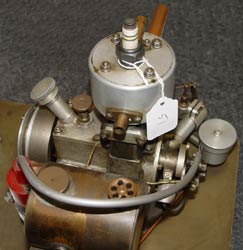 |
EM 30 Although it has a water jacket, this 30cc
two-stroke motor was designed as a hydroplane engine in the late 30s.
The design by W. Cooper
of King's Lynn
was published in English Mechanics magazine in 1938, hence the name. It
was part of a series that started on 1st April for the construction of a
metre hydroplane and engine. The hull was designed by R.W. Lance who
went to great pains to explain that he had deliberately ignored current
practice in the design. This was somewhat obvious as the hull would not
looked out of place in the 1920s. The EM 30 has powered a few boats
along the way, including those of Norman Dixon and Tom Clements, but at
4 1/2 lbs is no lightweight.
Part of a remarkable lifetimes engine
building by John Bertinat on display at Leamington. Jan 2010 |
©copyrightOTW2010














